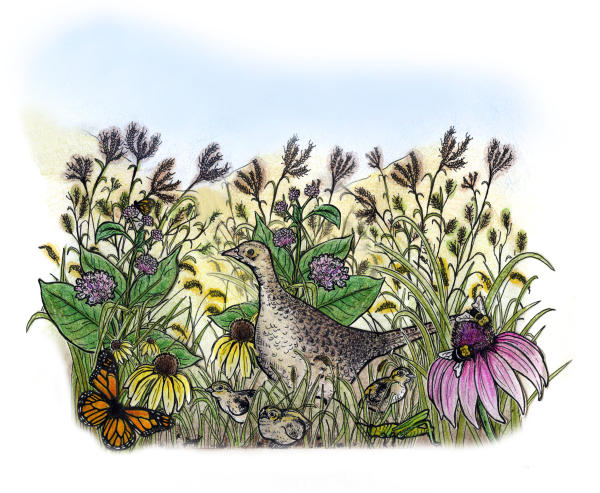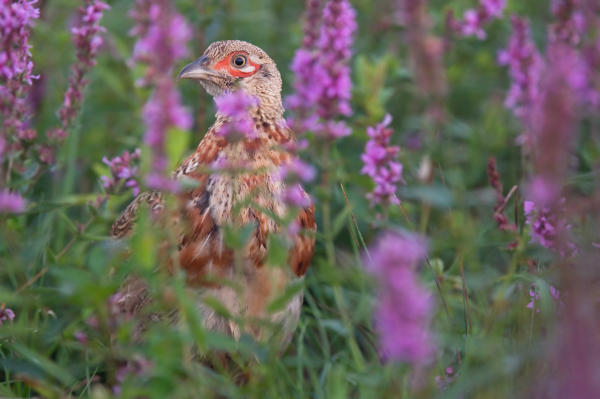Editor’s Note: This week is National Pollinator Week and I’m seeing folks both in and out of our industry sit up and take more notice of the plight of our pollinators. As well they should. For me, pollinators are an essential part of growing chocolate and coffee, key staples in my diet. So yes, I do have a butterfly garden and I’m happy when I see bees buzzing around my rose bushes. I try not to flip out too much when I see bats flying around at dusk around our patio – mosquitoes are also a huge problem in Minnesota. (Are there any benefits to the mosquito? I have yet to find one…but God doesn’t make mistakes…). I asked Jared Wiklund at Pheasants Forever if he could forward me one of their editorials they are pushing out this week, and I learned a new word “forb.” A forb, according to the author below is “…a herbaceous flowering plant that is not a graminid, or grass.” Or aka wildflowers. The author says wildflowers are even better cover for raising pheasants than grass. I’m all for that. Read on for more….
- Michelle Scheuermann, editor, Archery Wire
Grass is great pheasant habitat. But forbs are prime – for young birds, bees and butterflies alike. Flowers are the key.
By Tom Carpenter
Grass, grass, grass.
Grass is great. I love to walk through it any season of the year and see what’s hiding in it.
Autumn walks, of course, are best – preferably with my little Brittany coursing ahead in search of a sneaky old rooster … or maybe better yet, a nice fat young one that will sit tight for her.
Spring and summer sojourns are good too (sans canine of course during nesting and brood-rearing seasons) … with the chance of finding a covey of young birds and watching them buzz away to land close by and start peeping and calling to get back together with mama as I swerve off in the other direction.
THE FORB CONNECTI0N
But there is cover even better than grass for raising pheasant broods: Forbs. What’s a forb? Pretty simple: A herbaceous flowering plant that is not a graminid, or grass.
Call them wildflowers.
Pollinators – bees and butterflies – need those flowers, and flock to them to drink nectar. Forbs attract a variety of other insects too, many of which also need those flowers. The forb list includes such beauties (and beautiful names) as butterflyweed, coneflower, larkspur, paintbrush, black-eyed Susan, ironweed and indigo. The insect list includes beetles of all descriptions, grasshoppers, crickets, ants, aphids and just good old bugs of every description.

Those abundant, protein-rich insects are exactly what young pheasants need to eat to thrive and grow during the first two months of life. Seeds and fruits won’t do the job now, and grain wouldn’t either: To start, it’s an insect diet or death.
What’s more, the sturdy stems of forbs serve as excellent hiding cover for young and mature pheasants alike. Tiny, half-grown and full-sized birds can just more easily walk, forage, slither, scurry and run through for stems than they can the dense, ground-level, thick-as-a-carpet stems of grass.
FULL CIRCLE
It’s as simple as that: Forbs flower. The blooms and stems attract bees, butterflies and a host of insect life. That insect life feeds (and the forb stems house) insects and young pheasants. Full circle.
That’s precisely why upland bird fans also need to bee and butterfly guardians.
*According to the Center for Biological Diversity, over a quarter of all North American bee species are in danger of extinction. Yes, extinction. Where is your food going to come from when pollinating bees are gone from the landscape?
*According to the U.S. Fish and Wildlife Service, monarch butterfly populations have declined 90% over the last 20 years. They could be listed on the endangered species list as early as next year. Yes, the endangered species list. Where are we without handsome orange-and-black monarchs wafting on a summer breeze?

Pollinators need help – everybody’s help, and that includes conservation organizations of all descriptions, whether their members hunt or not. That’s why Pheasants Forever is leading the charge with so many other groups in the effort.
Grass is great. We always need more of it on the landscape. But the habitat mosaic needs forbs too. Wildlflowers. What you do for pollinator habitat today could help put a bird in your gamebag this fall, as well as save some other species … and maybe even us.
# # #